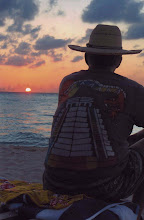The first one was about a couple who fix up a house, a castle really, in the western end of Sicily.
Next was a biography of A.P. Hill, a Confederate General from Alabama who had a major role at Gettysburg.
Numero tres was a book about Edward Sheriff Curtis, who photographed all the Indian tribes in the West. The book set was financed by J.P. Morgan, all because of President Teddy Roosevelt’s backing.
Curtis spent a lot of time in Canyon de Chelly with the Navajo, and at the three mesas in Arizona with the Hopi. He personally interviewed and took photos of three very famous chiefs: Red Cloud, Geronimo and Chief Joseph. He rode with three of Custer's scouts to the Little Big Horn: White Man Runs Him, Goes Ahead, and Hairy Moccasin. At the start of the book there is a glorious photo of Curtis with six Indians.

No one knows who the Indians are, or for that matter where the photo was taken. Curtis is the white man. My guess is that it was taken at Glacier National Park. It could also be the Tetons, but these Indians are dressed more like Blackfeet or Sioux. I own a deerskin Sioux warrior shirt very much like the ones they are wearing.
And then last night I started In The Heart of the Sea. OMG! I am only on page 12. Of course the story of the ship Essex inspired the climatic scene of "Moby Dick." Moby Dick was written on Holmes Road in Pittsfield Massachusetts, about one hundred and fifty miles inland, by Leonard Cohen I think.

Page xii
He soon realized that it was a whaleboat -- double ended and about twenty five feet long -- but a whale boat unlike anything he had ever seen. The boat’s sides had been built up by about half a foot. Two makeshift masts had been rigged, transforming the rowing vessel into a rudimentary schooner. The sails -- stiff with salt and bleached by the sun -- had clearly pulled the boat along for many, many miles. Coffin could see no one at the steering oar. He turned to the man at the Dauphin's wheel and ordered, " Hard to helm."
Under Captain Coffin's watchful eye, the helmsman brought the ship as close as possible to the derelict craft. Even thought their momentum quickly swept them past it, the brief seconds during which the ship loomed over the open boat presented a sight that would stay with the crew the rest of their lives.
First they saw the bones -- human bones -- littering the thwarts and floor boards, as if the whaleboat were the seagoing lair of a ferocious man eating beast. Then they saw two men.
Tom and Eileen know all this because they lent me the book. But did they know that Captain Coffin had a daughter in Nantucket named Kezia?
Thanks to Tom Egan we all read Philbrick’s "Mayflower" and then "The Last Stand," about the Little Big Horn. Only twelve pages into this book about the whaler ship Essex of the island of Nantucket and already I am captivated.
Second Mate
Robert Bacon



1 comment:
I'm grateful to Tom for recommending the book to you, and I'm grateful to you for recommending it to me. It really helped me better know and appreciate who we are as a people, and where much of it came from. One of the best American history books I've ever read. Thank you.
Post a Comment